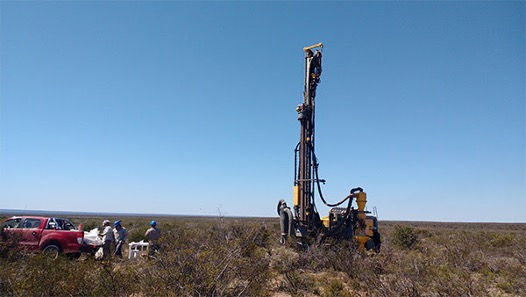Blue Sky Uranium Corp. (TSXV: BSK) has provided an update on exploration and development work carried out at its wholly owned Amarillo Grande Uranium-Vanadium Project in Rio Negro Province, Argentina (AGP), which includes the Ivana uranium-vanadium deposit.
Ivana Process Design Testwork
As an update to the process design testwork programme for Ivana, uranium/vanadium leach tests have been completed on the ~294 kg averaging 530ppm U3O8 composite bulk sample #2 prepared from RC chips from the Ivana deposit. The optimised leach conditions were 60 g/L Na2CO3 and 10 g/L NaHCO3, at 95∞C for 8 hours. For these new tests, uranium recovery for the alkaline leach stage was 96%, vanadium recovery was 35%.
In December 2018, Blue Sky completed a first set of process design tests for the Ivana uranium-vanadium mill. Based on this test work, the overall process plant recovery was 85% for uranium (derived from 89% leach feed preparation recovery and 95% subsequent alkaline leach circuit recovery); and 53% for vanadium (derived from 89% leach feed preparation recovery and 60% subsequent alkaline leach circuit recovery.)
Preparations are underway for testing the next step in the milling process: membrane filtration. Four litres of leach solution have been prepared for the small-scale membrane filtration tests, which will identify the best nanofiltration and reverse osmosis membranes for the process. Leaching of the remainder of mineralized sample #2 is underway to provide feed for the larger scale membrane filtration operation, which will provide solutions for subsequent solvent extraction tests.
Ivana Resources and Studies
Modelling work using external consultants has been advancing to evaluate the impact of the additional 3,346m of drilling in 350 RC drill holes and additional density measurements carried out in 2022 on the projects’ current mineral resources and the PEA completed in 2019. This work was carried out to refine the boundaries of the deposit and to potentially upgrade the category of mineral resources from inferred to indicated where possible.
Ivana East Drilling Programme
The previously announced RC drilling at Ivana East has been delayed due to technical issues with the drilling rig and will resume once it has been repaired. This programme is part of the company’s staged approach to evaluating targets with-in several tens of kilometres from the Ivana deposit that could add to the projects resource base.
Ivana Central Drilling Programme
Drilling at Ivana Central was initially launched in 2020, later suspended due to pandemic effect, and finally completed in 2022. The program totalled 2,607m of drilling in 43 scout holes; the first suxix holes drilled in 2020 were reverse circulation (RC) holes, the following 36 holes were drilled by direct circulation (DC) due to the geological conditions, and the last (AGIC-043) was drilled DC for the initial 31m and was completed as a diamond drill hole with core recovered.
Radiometric borehole surveys were run from hole AGIC-007 to AGIC-043. It was not possible to survey the initial 6 RC holes due to the geological conditions. All holes were vertical, and due to flat strata, sample results are believed to approximate true thickness.
Based on borehole radiometric anomalies and chip logging, the target REDOX front is understood to have been intercepted in 18 holes, delineating a +2.4km long and +1km wide NNW-SSE corridor at between 40m and 60m, open to the north and south and Figure 3). This REDOX front is characterized by “black” sandstones with organic matter and disseminated pyrite, accompanied by radiometric anomalies in most cases. This “black sand” horizon was initially identified at hole AGIC-01, where it yielded 1.0m @120ppm U3O8 at 46m in depth.
A total of 281 1m samples were collected from RC holes AGIC 001-006; Uranium ranged from less than detection to 120 ppm U3O8 in 1m samples. Only 56 cutting samples were recovered from the scout drillholes AGIC -007 to AGIC 042 due to recovery limitations; samples recovered from these holes designed for prospecting have potential for contamination due to the DC drilling technique employed. Uranium ranged from less than detection to 32 ppm U3O8 from 1m samples. Radiometric probe results ranged up to 1442 cps (AGC-028), a result consistent with uranium results in the 150ppm U range based on correlation with other drilling on the project.
Hole AGIC-043, the last in the programme, was drilled in order to better define and assess the geological characteristics of the REDOX front with anomalous uranium and radiometric levels that had been intersected by previous DC drilled holes. The recovery of drill core in AGIC-043 permitted detailed logging of the geological units and the collection of better-quality samples. The hole cut predominantly fine tuffaceous sediments from surface to 38m in depth, and predominantly sandy sediments from 38 to 63m in depth, ending the hole with more fine tuffaceous material at 65m. The black sand horizon was intersected between 46 and 62m in depth, interpreted as the REDOX front. Multiple samples with elevated silver-cobalt-copper-uranium-tungsten were observed in the analytical results and, and in the case of the high-silver samples (0.35m at 2880 ppm Ag), the core permitted re-sampling of ¼ core for confirmation analyses.
Two additional discontinuous radiometric anomalous “black sand” horizons were intercepted at shallower depths in the 20-30m depth range in several holes. These black sand units correlate with chargeability anomalies identified in the IP Pole-Dipole surveys covering the area. Further follow-up of the projected extent of the REDOX front at Ivana Central and assessing of the high-grade silver potential is being carried out by the Company.
Ongoing Exploration Programme
Regional prospecting mapping, sampling, and radiometric surveys have been carried out over the southern sector of the Amarillo Grande project. The programme is collecting soil samples for detection of Pb-isotopic anomalies that may be related to uranium-sandstone type deposit or REDOX fronts. The exploration efforts are completed with pit sampling or auger drilling when uranium mineralization and/or radiometric anomalies are detected while mapping.
For further information please visit: https://blueskyuranium.com/












